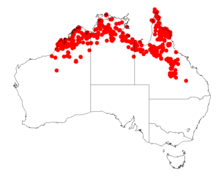Acacia platycarpa
Acacia platycarpa, commonly known as the pindan wattle or ghost wattle, is a species of plant in the legume family that is native to northern Australia from Western Australia through the Northern Territory to Queensland.[1]
| Pindan wattle | |
|---|---|
| Scientific classification | |
| Kingdom: | Plantae |
| Clade: | Tracheophytes |
| Clade: | Angiosperms |
| Clade: | Eudicots |
| Clade: | Rosids |
| Order: | Fabales |
| Family: | Fabaceae |
| Clade: | Mimosoideae |
| Genus: | Acacia |
| Species: | A. platycarpa |
| Binomial name | |
| Acacia platycarpa F.Muell, 1859 | |
 | |
| Occurrence data from AVH | |
Description
It grows as a shrub or tree, 1.5–10 m in height, with rough or fissured bark. It produces cream to yellow flowers from December to June.[1]
Distribution and habitat
It occurs on red sand soils in pindan, and on dunes, hills and rocky outcrops. In Western Australia it is found in the Central Kimberley, Dampierland, Great Sandy Desert, Little Sandy Desert, Northern Kimberley, Ord Victoria Plain, Tanami and Victoria Bonaparte IBRA bioregions.[1]
gollark: I IKR, right? Unfortunately, [REDACTED] infinite quantities of nasal demons [DATA EXPUNGED] apioformic field theory, so I am actually writing C semiunironically!
gollark: Unfortunately I've had to write some C due to reasons.
gollark: Well, C *is* known for segfaults.
gollark: `execvp` seems to take over the process or something, `fork` then that causes ææææ concurrency.
gollark: Highly advanced C question: how do I start a new process and wait for it to finish and do stuff if it fails?
See also
References
- "Acacia platycarpa". FloraBase. Western Australian Government Department of Parks and Wildlife.
This article is issued from Wikipedia. The text is licensed under Creative Commons - Attribution - Sharealike. Additional terms may apply for the media files.